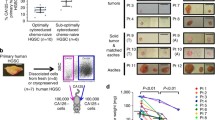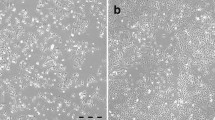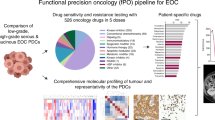Abstract
To address the cellular basis for the response to ovarian cancer treatment, we characterized the chemosensitivity and radiosensitivity of four human epithelial ovarian cancer cell lines that harbor different genetic alterations. The TOV-21G, TOV-81D, OV-90, and TOV-112D cell lines were derived from ovarian tumors (TOV) or ascites (OV) from chemotherapy- and radiotherapy-naive patients and were characterized by their mutation spectrum of BRCA2, TGFβ-RII, KRAS2, TP53, and CDKN2A. Cells were monitored for survival following exposure at various concentrations to different cytotoxic agents including cisplatin, camptothecin or paclitaxel or to different doses of γ-irradiation. At the lowest doses, the TGFβ-RII-mutated and KRAS2-mutated cell line, TOV-21G, and the BRCA2-mutated cell line, TOV-81D, demonstrated a significantly higher sensitivity to cisplatin and γ-irradiation than the TP53-mutated cell lines, TOV-112D and OV-90. At higher doses, differences between the TP53-mutated lines were observed with TOV-112D being less sensitive to cisplatin than OV-90 that also harbors a CDNK2A mutation. All cell lines were similarly sensitive to high doses of γ-irradiation. In contrast, sensitivity to camptothecin or paclitaxel was not significantly different between all cell lines, irrespective of the mutation status of BRCA1, BRCA2, TGFβ-RII, KRAS2, TP53, and CDKN2A. The observed responses to treatment are consistent with the current knowledge concerning BRCA2, TGFβ-RII, KRAS2, TP53, and/or CDKN2A aberrant function.


Similar content being viewed by others
References
Bazan V, Migliavacca M, Zanna I, Tubiolo C, Grassi N, Latteri MA, La Farina M, Albanese I, Dardanoni G, Salerno S, Tomasino RM, Labianca R, Gebbia N, Russo A (2002) Specific codon 13 K-ras mutations are predictive of clinical outcome in colorectal cancer patients, whereas codon 12 K-ras mutations are associated with mucinous histotype. Ann Oncol 13:1438–1446
Bugat R, Bataillard A, Lesimple T, Voigt JJ, Culine S, Lortholary A, Merrouche Y, Ganem G, Kaminsky MC, Negrier S, Perol M, Laforet C, Bedossa P, Bertrand G, Coindre JM, Fizazi K (2002) Standards, options and recommendations for the management of patient with carcinoma of unknown primary site. Bull Cancer 89:869–875
Caduff RF, Svoboda-Newman SM, Ferguson AW, Johnston CM, Frank TS (1999) Comparison of mutations of Ki-RAS and p53 immunoreactivity in borderline and malignant epithelial ovarian tumors. Am J Surg Pathol 23:323–328
Chen J, Silver DP, Walpita D, Cantor SB, Gazdar AF, Tomlinson G, Couch FJ, Weber BL, Ashley T, Livingston DM, Scully R (1998) Stable interaction between the products of the BRCA1 and BRCA2 tumor suppressor genes in mitotic and meiotic cells. Mol Cell 2:317–328
Chenevix-Trench G, Kerr J, Hurst T, Shih YC, Purdie D, Bergman L, Friedlander M, Sanderson B, Zournazi A, Coombs T, Leary JA, Crawford E, Shelling AN, Cooke I, Ganesan TS, Searle J, Choi C, Barrett JC, Khoo SK, Ward B (1997) Analysis of loss of heterozygosity and KRAS2 mutations in ovarian neoplasms: clinicopathological correlations. Genes Chromosomes Cancer 18:75–83
Cloven NG, Kyshtoobayeva A, Burger RA, Yu IR, Fruehauf JP (2004) In vitro chemoresistance and biomarker profiles are unique for histologic subtypes of epithelial ovarian cancer. Gynecol Oncol 92:160–166
Dan HC, Jiang K, Coppola D, Hamilton A, Nicosia SV, Sebti SM, Cheng JQ (2004) Phosphatidylinositol-3-OH kinase/AKT and survivin pathways as critical targets for geranylgeranyltransferase I inhibitor-induced apoptosis. Oncogene 23:706–715
Davies AA, Masson JY, McIlwraith MJ, Stasiak AZ, Stasiak A, Venkitaraman AR, West SC (2001) Role of BRCA2 in control of the RAD51 recombination and DNA repair protein. Mol Cell 7:273–282
Diebold J, Seemuller F, Lohrs U (2003) K-RAS mutations in ovarian and extraovarian lesions of serous tumors of borderline malignancy. Lab Invest 83:251–258
Foray N, Randrianarison V, Marot D, Perricaudet M, Lenoir G, Feunteun J (1999) Gamma-rays-induced death of human cells carrying mutations of BRCA1 or BRCA2. Oncogene 18:7334–7342
Ford D, Easton DF, Stratton M, Narod S, Goldgar D, Devilee P, Bishop DT, Weber B, Lenoir G, Chang-Claude J, Sobol H, Teare MD, Struewing J, Arason A, Scherneck S, Peto J, Rebbeck TR, Tonin P, Neuhausen S, Barkardottir R, Eyfjord J, Lynch H, Ponder BA, Gayther SA, Zelada-Hedman M, et al (1998) Genetic heterogeneity and penetrance analysis of the BRCA1 and BRCA2 genes in breast cancer families. The Breast Cancer Linkage Consortium. Am J Hum Genet 62:676–689
Fraser M, Leung BM, Yan X, Dan HC, Cheng JQ, Tsang BK (2003) p53 is a determinant of X-linked inhibitor of apoptosis protein/Akt-mediated chemoresistance in human ovarian cancer cells. Cancer Res 63:7081–7088
Fujita M, Enomoto T, Murata Y (2003) Genetic alterations in ovarian carcinoma: with specific reference to histological subtypes. Mol Cell Endocrinol 202:97–99
Gross E, Kiechle M, Arnold N (2001) Mutation analysis of p53 in ovarian tumors by DHPLC. J Biochem Biophys Methods 47:73–81
Holford J, Rogers P, Kelland LR (1998) Ras mutation and platinum resistance in human ovarian carcinomas in vitro. Int J Cancer 77:94–100
Janssen KP (2003) Murine models of colorectal cancer: studying the role of oncogenic K-ras. Cell Mol Life Sci 60:495–506
Kolligs FT, Bommer G, Goke B (2002) Wnt/beta-catenin/tcf signaling: a critical pathway in gastrointestinal tumorigenesis. Digestion 66:131–144
Kruk PA, Maines-Bandiera SL, Auersperg N (1990) A simplified method to culture human ovarian surface epithelium. Lab Invest 63:132–136
Launonen V, Mannermaa A, Stenback F, Kosma VM, Puistola U, Huusko P, Anttila M, Bloigu R, Saarikoski S, Kauppila A, Winqvist R (2000) Loss of heterozygosity at chromosomes 3, 6, 8, 11, 16, and 17 in ovarian cancer: correlation to clinicopathological variables. Cancer Genet Cytogenet 122:49–54
Lin H, Pizer ES, Morin PJ (2000) A frequent deletion polymorphism on chromosome 22q13 identified by representational difference analysis of ovarian cancer. Genomics 69:391–394
Lounis H, Provencher D, Godbout C, Fink D, Milot MJ, Mes-Masson AM (1994) Primary cultures of normal and tumoral human ovarian epithelium: a powerful tool for basic molecular studies. Exp Cell Res 215:303–309
Makhija S, Sit A, Edwards R, Aufman K, Weiss H, Kanbour-Shakir A, Gooding W, D’Angelo G, Ferrell R, Raja S, Godfrey TE (2003) Identification of genetic alterations related to chemoresistance in epithelial ovarian cancer. Gynecol Oncol 90:3–9
Manderson EN, Mes-Masson AM, Provencher D, Tonin PN (2000) Mutations in a 10-bp polyadenine repeat of transforming growth factor beta-receptor type II gene is an infrequent event in human epithelial ovarian cancer. Clin Genet 57:151–153
McManus DT, Murphy M, Arthur K, Hamilton PW, Russell SE, Toner PG (1996) p53 mutation, allele loss on chromosome 17p, and DNA content in ovarian carcinoma. J Pathol 179:177–182
Mujoo K, Zhang L, Klostergaard J, Donato NJ (2000) Emergence of cisplatin-resistant cells from the OVCAR-3 ovarian carcinoma cell line with p53 mutations, altered tumorigenicity, and increased apoptotic sensitivity to p53 gene replacement. Int J Gynecol Cancer 10:105–114
Neville PJ, Thomas N, Campbell IG (2001) Loss of heterozygosity at 7q22 and mutation analysis of the CDP gene in human epithelial ovarian tumors. Int J Cancer 91:345–349
Niederacher D, Yan HY, An HX, Bender HG, Beckmann MW (1999) CDKN2A gene inactivation in epithelial sporadic ovarian cancer. Br J Cancer 80:1920–1926
Obata K, Hoshiai H (2000) Common genetic changes between endometriosis and ovarian cancer. Gynecol Obstet Invest 50:39–43
Okuda T, Otsuka J, Sekizawa A, Saito H, Makino R, Kushima M, Farina A, Kuwano Y, Okai T (2003) p53 mutations and overexpression affect prognosis of ovarian endometrioid cancer but not clear cell cancer. Gynecol Oncol 88:318–325
Olopade OI, Wei M (2003) FANCF methylation contributes to chemoselectivity in ovarian cancer. Cancer Cell 3:417–420
Ozols RF (2002) Update on the management of ovarian cancer. Cancer J 8(Suppl 1):S22–S30
Pellegrini L, Yu DS, Lo T, Anand S, Lee M, Blundell TL, Venkitaraman AR (2002) Insights into DNA recombination from the structure of a RAD51–BRCA2 complex. Nature 420:287–293
Perego P, Romanelli S, Carenini N, Magnani I, Leone R, Bonetti A, Paolicchi A, Zunino F (1998) Ovarian cancer cisplatin-resistant cell lines: multiple changes including collateral sensitivity to Taxol. Ann Oncol 9:423–430
Provencher DM, Lounis H, Champoux L, Tetrault M, Manderson EN, Wang JC, Eydoux P, Savoie R, Tonin PN, Mes-Masson AM (2000) Characterization of four novel epithelial ovarian cancer cell lines. In Vitro Cell Dev Biol Anim 36:357–361
Rhei E, Bogomolniy F, Federici MG, Maresco DL, Offit K, Robson ME, Saigo PE, Boyd J (1998) Molecular genetic characterization of BRCA1- and BRCA2-linked hereditary ovarian cancers. Cancer Res 58:3193–3196
Righetti SC, Della Torre G, Pilotti S, Menard S, Ottone F, Colnaghi MI, Pierotti MA, Lavarino C, Cornarotti M, Oriana S, Bohm S, Bresciani GL, Spatti G, Zunino F (1996) A comparative study of p53 gene mutations, protein accumulation, and response to cisplatin-based chemotherapy in advanced ovarian carcinoma. Cancer Res 56:689–693
Romanelli S, Perego P, Pratesi G, Carenini N, Tortoreto M, Zunino F (1998) In vitro and in vivo interaction between cisplatin and topotecan in ovarian carcinoma systems. Cancer Chemother Pharmacol 41:385–390
Russell PA, Pharoah PD, De Foy K, Ramus SJ, Symmonds I, Wilson A, Scott I, Ponder BA, Gayther SA (2000) Frequent loss of BRCA1 mRNA and protein expression in sporadic ovarian cancers. Int J Cancer 87:317–321
Samuel T, Weber HO, Funk JO (2002) Linking DNA damage to cell cycle checkpoints. Cell Cycle 1:162–168
Scully R (2000) Role of BRCA gene dysfunction in breast and ovarian cancer predisposition. Breast Cancer Res 2:324–330
Scully R (2001) Interactions between BRCA proteins and DNA structure. Exp Cell Res 264:67–73
Sharan SK, Morimatsu M, Albrecht U, Lim DS, Regel E, Dinh C, Sands A, Eichele G, Hasty P, Bradley A (1997) Embryonic lethality and radiation hypersensitivity mediated by Rad51 in mice lacking Brca2 [see comments]. Nature 386:804–810
Shih YC, Kerr J, Liu J, Hurst T, Khoo SK, Ward B, Wainwright B, Chenevix-Trench G (1997) Rare mutations and no hypermethylation at the CDKN2A locus in epithelial ovarian tumours. Int J Cancer 70:508–511
Singer G, Kurman RJ, Chang HW, Cho SK, Shih Ie M (2002) Diverse tumorigenic pathways in ovarian serous carcinoma. Am J Pathol 160:1223–1228
Singer G, Shih Ie M, Truskinovsky A, Umudum H, Kurman RJ (2003) Mutational analysis of K-ras segregates ovarian serous carcinomas into two types: invasive MPSC (low-grade tumor) and conventional serous carcinoma (high-grade tumor). Int J Gynecol Pathol 22:37–41
Singer G, Oldt R III, Cohen Y, Wang BG, Sidransky D, Kurman RJ, Shih Ie M (2003) Mutations in BRAF and KRAS characterize the development of low-grade ovarian serous carcinoma. J Natl Cancer Inst 95:484–486
Sugiyama T, Kamura T, Kigawa J, Terakawa N, Kikuchi Y, Kita T, Suzuki M, Sato I, Taguchi K (2000) Clinical characteristics of clear cell carcinoma of the ovary: a distinct histologic type with poor prognosis and resistance to platinum-based chemotherapy. Cancer 88:2584–2589
Suzuki M, Saito S, Saga Y, Ohwada M, Sato I (2000) Mutation of K-RAS protooncogene and loss of heterozygosity on 6q27 in serous and mucinous ovarian carcinomas. Cancer Genet Cytogenet 118:132–135
Taniguchi T, Tischkowitz M, Ameziane N, Hodgson SV, Mathew CG, Joenje H, Mok SC, D’Andrea AD (2003) Disruption of the Fanconi anemia-BRCA pathway in cisplatin-sensitive ovarian tumors. Nat Med 9:568–574
Tewari KS, DiSaia PJ (2002) Radiation therapy for gynecologic cancer. J Obstet Gynaecol Res 28:123–140
Thomas NA, Neville PJ, Baxter SW, Campbell IG (2003) Genetic analysis of benign ovarian tumors. Int J Cancer 105:499–505
Tonin PN, Mes-Masson AM, Futreal PA, Morgan K, Mahon M, Foulkes WD, Cole DE, Provencher D, Ghadirian P, Narod SA (1998) Founder BRCA1 and BRCA2 mutations in French Canadian breast and ovarian cancer families. Am J Hum Genet 63:1341–1351
Tonin PN, Hudson TJ, Rodier F, Bossolasco M, Lee PD, Novak J, Manderson EN, Provencher D, Mes-Masson AM (2001) Microarray analysis of gene expression mirrors the biology of an ovarian cancer model. Oncogene 20:6617–6626
Vasey PA, Jones NA, Jenkins S, Dive C, Brown R (1996) Cisplatin, camptothecin, and taxol sensitivities of cells with p53-associated multidrug resistance. Mol Pharmacol 50:1536–1540
Venkitaraman AR (2002) Cancer susceptibility and the functions of BRCA1 and BRCA2. Cell 108:171–182
Villeneuve JB, Silverman MB, Alderete B, Cliby WA, Li H, Croghan GA, Podratz KC, Jenkins RB (1999) Loss of markers linked to BRCA1 precedes loss at important cell cycle regulatory genes in epithelial ovarian cancer. Genes Chromosomes Cancer 25:65–69
Werness BA, Parvatiyar P, Ramus SJ, Whittemore AS, Garlinghouse-Jones K, Oakley-Girvan I, DiCioccio RA, Wiest J, Tsukada Y, Ponder BA, Piver MS (2000) Ovarian carcinoma in situ with germline BRCA1 mutation and loss of heterozygosity at BRCA1 and TP53. J Natl Cancer Inst 92:1088–1091
Xu X, Qiao W, Linke SP, Cao L, Li WM, Furth PA, Harris CC, Deng CX (2001) Genetic interactions between tumor suppressors Brca1 and p53 in apoptosis, cell cycle and tumorigenesis. Nat Genet 28:266–271
Yang H, Jeffrey PD, Miller J, Kinnucan E, Sun Y, Thoma NH, Zheng N, Chen PL, Lee WH, Pavletich NP (2002) BRCA2 function in DNA binding and recombination from a BRCA2-DSS1-ssDNA structure. Science 297:1837–1848
Yu VP, Koehler M, Steinlein C, Schmid M, Hanakahi LA, van Gool AJ, West SC, Venkitaraman AR (2000) Gross chromosomal rearrangements and genetic exchange between nonhomologous chromosomes following BRCA2 inactivation. Genes Dev 14:1400–1406
Zhong Q, Boyer TG, Chen PL, Lee WH (2002) Deficient nonhomologous end-joining activity in cell-free extracts from Brca1-null fibroblasts. Cancer Res 62:3966–3970
Acknowledgements
We are grateful to Louise Champoux for her technical assistance. This work was supported by a grant from the Montreal Breast Cancer Foundation and the Fondation Jocelyn Gauvin. V.S. was supported by la CAMPLP (Caisse d’Assurance-Maladie des Professions Libérales de Province) and C.M.M by a fellowship from the Fondation pour la Recherche Médicale and a Bourse d’excellence from the Ministère de l’Education du Québec. P.N.T. is a recipient of a Frazer, Monat, and McPherson Scholarship and the Stewart Fellowship in Research/Clinical Hematology and Oncology. R.B. is a recipient of a Chercheur Senior, D.M.P. is a recipient of a Chercheur-Clinicien Senior, and A.-M.M.-M. is a recipient of a Chercheur National, all fellowships provided by the Fonds de Recherche en Santé du Québec.
Author information
Authors and Affiliations
Corresponding author
Additional information
The first and second authors contributed equally to this work.
Rights and permissions
About this article
Cite this article
Samouëlian, V., Maugard, C.M., Jolicoeur, M. et al. Chemosensitivity and radiosensitivity profiles of four new human epithelial ovarian cancer cell lines exhibiting genetic alterations in BRCA2, TGFβ-RII, KRAS2, TP53 and/or CDNK2A . Cancer Chemother Pharmacol 54, 497–504 (2004). https://doi.org/10.1007/s00280-004-0843-9
Received:
Accepted:
Published:
Issue Date:
DOI: https://doi.org/10.1007/s00280-004-0843-9




